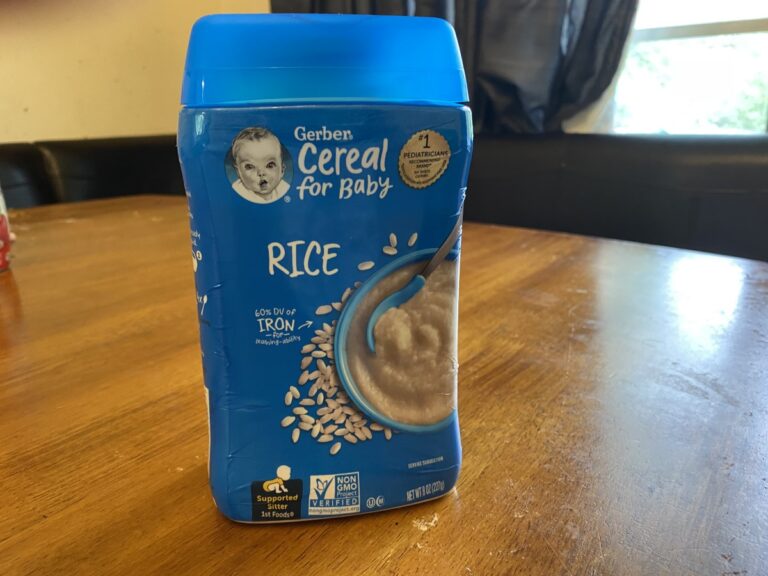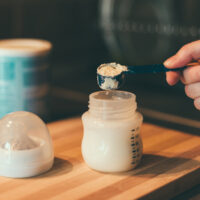As your child gets closer to that six-month mark, you’ll have to decide what types of food to feed them. You may be considering oatmeal cereal vs. rice cereal vs. other cereal options. Below, you’ll find a comparison of oatmeal and rice cereal as well as what you need to know about starting your baby on their first foods.
Oatmeal vs. Rice Cereal
Both oatmeal and rice cereal have their advantages and disadvantages. Below, we’ll take a look at oatmeal vs. rice cereal in several categories so you can choose which one is best for your baby.
Nutrition
Oatmeal is made from oats, while rice cereal is made from fortified rice. Both are a type of grain that may come from organic or non-organic farms. Rice cereal is fortified with iron and fills your baby up, so it might be a good choice if your little one is still hungry after eating a full day’s worth of breastmilk or formula. Oatmeal has a better nutritional profile than rice and it is also high in fiber. Since it’s a complex carbohydrate instead of a processed simple carbohydrate like rice, oatmeal is also going to keep your little one full for a longer period of time.
Digestion
Most babies tolerate rice cereal well. It is easy enough to digest if you wait until they are old enough to eat baby cereal. For babies that do struggle with digesting rice cereal, oatmeal might be the better choice. Oatmeal is high in fiber that your baby’s body can break down better and more effectively than rice cereal. If your baby does become constipated after eating rice cereal, you’ll want to switch.
Oatmeal is also a good choice for babies with a higher risk of allergies or sensitivity to gluten. If your family has a history of Celiac’s disease (which causes severe digestive issues if you eat gluten), oatmeal cereal may also be a better choice.
Taste and Texture
For some babies that prefer one type of cereal over the other, the taste or texture may be off-putting. Oatmeal isn’t as smooth as rice cereal, however, some babies tolerate it well. You can also make oatmeal thinner to smooth the consistency. Rice is smoother in texture and milder in flavor. It is bland and well-tolerated but some babies do enjoy the nutty flavor profile of oatmeal.
Possible Dangers of Rice Cereal for Babies
One concern with rice cereal is that rice grains easily absorb arsenic from the environment, more so than other grains you’d be feeding your baby. Arsenic is found in trace amounts in drinking water and other sources, however, it is heavily regulated. Arsenic is a neurotoxin and carcinogen. When your baby is exposed to large amounts, it can permanently reduce their IQ.
The FDA released guidelines in 2016 after testing levels of arsenic in baby rice cereal between 2011 and 2013. Many manufacturers looked for better sources of rice that had less exposure to environmental arsenic. In 2022 when the brands were tested again, 76% of them met the 100 ppb recommendation, compared to 36% with earlier testing. They have released an official list of their testing results, so you can refer to this as you choose a brand for your baby.
Something else to note is that you should not feed your baby more than 1/4 cup of rice cereal per day. It doesn’t have as much nutritional value as other grain alternatives. Additionally, watch out for rice snacks including rice teether crackers that will also count toward your baby’s total amount of rice.
Oatmeal vs. Rice Cereal vs. Other Alternatives
In my opinion, oatmeal cereal is the better choice. Since it is high in fiber, it’s less likely to cause digestive issues for your little one. It is also gluten-free and has more vitamins than rice cereal. Additionally, as a complex carbohydrate, it is going to keep them full longer. My sons both really enjoyed the fluffy texture of oatmeal with fruit baby food when they were younger, too.
Even though oatmeal is nutritionally better, rice does have a smoother, simpler profile. It is a good transition food because it isn’t especially flavored, especially when it’s made with formula or breastmilk because your baby is already familiar with the flavor. It is also a good choice for introducing different foods if your baby tolerates it well, including first foods like mashed fruit, baby food, and cottage cheese. If you do decide that rice cereal is the better choice for your baby, you’ll want to do your research and choose a brand with low arsenic levels.
While oatmeal and rice are the most well-known choices, there are several other alternative grains used to make baby food. Barley, quinoa, buckwheat, and multigrain blends are also common. Many of the alternative grains are similar to oatmeal because they have a nuttier flavor and a better nutritional profile than rice cereal. If your baby doesn’t like oatmeal, then you can try a multigrain or barley cereal instead before switching to rice cereal.
How to Introduce Baby Cereal (and Other Solids) to Your Baby
As you introduce baby cereal to your infant, something to keep in mind is that you’ll need to play around with how often you are feeding them until you find what works. Additionally, keep in mind that food should only be part of what your infant eats each day. Even if you wait until six months to introduce baby cereal and other food, it is more about getting your baby used to eat food than it is about nutrition. Introducing them to new foods will make it easier to wean once the time comes.
Developing a Feeding Schedule
You’ll want to offer formula or breastmilk either before or after your baby eats solid foods. Pay attention to your baby’s patterns and how much they eat. Do they tend to breastfeed or have a bottle and then not want food for several hours, or are they hungry for a snack not long after they eat? If your baby isn’t getting full-on milk or formula, it’s okay to offer this first. If they do get full for several hours, you’ll want to give them food and then offer milk or formula.
Around age 6-9 months, once your baby is interested in food, you’ll want to start them on a feeding schedule. Set times for breakfast, lunch, and dinner and feed your baby food or cereal around then. Don’t force your baby to eat if they aren’t hungry; keep in mind this is only to help them adjust to a schedule and they don’t need anything aside from breastmilk or formula anyway.
You’ll want to be sure that your baby is drinking 20-28 ounces of formula or breastfeeding every 3-4 hours per day in addition to foods being offered. Follow these guidelines for up to 9 months. Between 9 and 12 months, be sure your little one is getting 16-24 ounces of formula per day or feeding every 4-5 hours.
How Much Should I Feed My Baby?
Baby’s stomachs are very small and you should avoid overfeeding them. Never force your baby to eat unfinished food or formula. Overeating makes it more likely that your baby will throw up after eating and puts them at higher risk of acid reflux. Additionally, it confuses their hunger and satiety cues. This can put a strain on their relationship with food and lead to problems like excess weight gain.
If you decide your baby before they are six months old, you shouldn’t feed them more than 2-4 tablespoons of food at mealtime. You also should limit food consumption to twice a day. Between 7-12 months, you can feed your baby three meals per day. As a guideline, your baby’s stomach is about the size of their fist. However, you’ll want to be sure they are drinking as much formula or breastmilk as they need while feeding them this amount.
Feeding Your Baby Cereal
Baby cereals are fortified with iron, which is a nutrient your baby might struggle with getting after they leave the womb. While there are small amounts in their mother’s breastmilk or formula, research shows most babies reach their lowest level of iron as early as 5 months. This is a great reason to use iron-fortified baby cereal once you decide it’s time to introduce food to your little one.
The best way to start with cereal is to mix it with breastmilk or formula. You’ll want to add 1 tablespoon of baby cereal to 4-5 teaspoons of liquid. This will still be liquid enough that your baby may be able to swallow it. Keep in mind that the texture is going to be a new experience to them after drinking their first 4-6 months of life. It is very likely that your baby’s cereal will end up mostly on their face and chin the first few times you feed them. They won’t be as easily able to swallow the texture without practice. As their ability to swallow cereal gets better, you can thicken the cereal by adding less liquid or more cereal.
Feeding Your Baby Fruits, Vegetables, and Meats
Once you decide to start your baby on foods, you can introduce pureed fruits, vegetables, and meats. Most experts recommend introducing these types of foods between 4 and 6 months of age. It can also be useful to try a wide variety of foods since your baby will be more inclined to try new things if they get in the habit while they are younger. The AAP also states that babies may be less likely to develop food allergies if they try them while they are young.
While you do want to introduce a variety of foods, you’ll want to do it slowly. Introduce one food to your baby at a time, then wait a few days before introducing another one. This gives you time to monitor their stool (some foods might give your baby a diaper rash). Other signs of an allergic reaction include redness and swelling, hives, or a rash around your baby’s face. If their throat swells or they have difficulty breathing, you’ll need to take your baby to the emergency room immediately.
Single-Ingredient Finger Foods
Most babies are excited about finger foods because they can grasp them and feed themselves. You can start with finger foods from 6-8 months of age. If you notice your baby reaching for the spoon or trying to feed themselves, you should let them. It will make a big mess, but it’s an important developmental milestone.
Some good single-ingredient finger foods are softened fruits and vegetables (like baked, skinned apples or soft green beans). Babies also might grasp at mashed potatoes or avocadoes at this age. Something to keep in mind is that the shape of foods has a lot to do with how easy their little pudgy fingers can grasp at them. You’ll also want to be sure the foods are soft enough that they mash if you press on them with your thumb and forefinger.
Chunkier Foods
Once your baby tolerates soft foods well, you can start to introduce chunkier mashes, as well as ground and chopped foods. Cottage cheese, chunky sweet potatoes, and mashed bananas are all good places to start. You can also give ground meat a little bit more texture. Generally, your baby is ready to eat these chunkier foods by the time they are 9-12 months old.
If you’re curious about when it’s a good time to stop formula, check out our tips here.
FAQs about Oatmeal vs. Rice Cereal for Baby
Can I put baby cereal in my baby’s bottle?
Something that mothers used to do was put a little baby cereal in their baby’s bottle to help them sleep longer. This might have even happened before baby was four months when their digestive tract was not yet ready to process baby cereal or other foods.
According to the CDC, you should never put cereal in your baby’s bottle. The myth that it helps your little one sleep longer is an old wives tale. Additionally, giving baby cereal too early replaces nutrition that your little one needs and it poses a choking hazard.
When can I start feeding my baby cereal?
Most babies are ready for breakfast cereal between 4 and 6 months. Something to note is that your baby gets all the nutrition they need from formula or breastmilk. You’ll only want to introduce food early if they are still hungry after a full day’s portion of food, which is around 8-10 feedings for breastfed babies and around 32-ounces of formula.
Something to note is that the American Academy of Pediatrics recommends exclusively breastfeeding or formula feeding for the first six months. Even though your baby can tolerate baby cereal and other foods as early as four months, it still might be best to wait unless you talk to your pediatrician about what type of feeding schedule will work best for your little one.
In addition to eating enough breastmilk or formula, your baby needs to meet several developmental milestones. You shouldn’t feed your baby food until:
- She can hold up her head while sitting
- He doesn’t have a tongue thrust reflex (this causes him to automatically push food from his mouth)
- They show an interest in food
Even though feeding your baby food is an exciting milestone, it’s best to wait until you’re sure they are ready. They get all the nutrition they need from breastmilk or formula and food should only be used as a supplement until they are over 1 year of age.
Do I need to feed my baby infant cereal?
No, you do not have to give infant cereal if you do not want to. The reason that baby cereal is recommended by pediatricians as a first food is that it provides iron. Your baby’s need for iron increases significantly around six months and they may not be getting all they need from their mother’s breastmilk. If you are worried and don’t want to start cereal, you can talk to your child’s doctor about alternatives or supplementation.
If you do decide that baby cereal isn’t for your family, you will need to give them more meats around 6-8 months. Meat is a good alternative to iron, as are beans, peas, and lentils. Talk to your baby’s pediatrician about how much is needed to ensure your little one is getting all the vitamins and minerals they need for healthy development.
Final Word
When it comes to oatmeal vs. rice cereal, our top choice is oatmeal. While not all babies will enjoy the fluffy texture and nutty flavor profile, it does have more nutrition than iron-fortified rice cereal. Additionally, it is less likely to cause constipation or allergic reactions from gluten. Once you decide which type of cereal you want to try, you can find our list of best baby cereal here. We offered suggestions for multigrain cereals like oatmeal as well as rice cereals, so there’s something for every baby.






